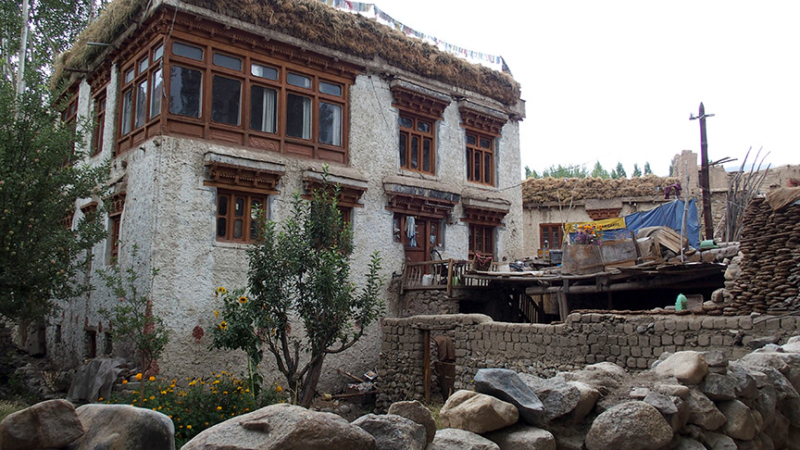Walking around the relatively green northern side of Leh, we looked for a cozy room where we could recover from the surprisingly powerful effects of altitude sickness. One place stood out because of its peaceful location and unobstructed views of the mountains off to the west and south. A deal was struck with the owners and we ended up staying for a good while. It was an informal place where we could do our own thing – a “homestay”. Meals could be arranged with Gunzang, the lady of the house if we wanted, but neither she nor her husband spoke much English so we mostly just fended for ourselves. It wasn’t like they had a restaurant with a menu or a reception desk or anything like that. It was a family home with extra rooms and it gave us an intimate look at many aspects of traditional Ladakhi life, which turned out to be one of the most interesting experiences we’ve had so far on this journey.
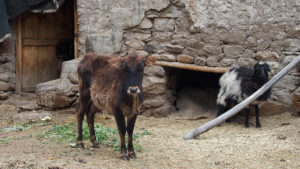
During that time we got acquainted with certain parts of town and soaked up a good dose of Leh’s considerable charms. Ladakh is a remote state in the extremely arid and rugged Himalayas of northern India. The native Ladakhis seem to be closely related to Tibetans, although they’re definitely their own distinct entity. A large number of Tibetans live there too, many of them refugees, and they fit in nicely, particularly since the Ladakhis and Tibetans both practice a special variety of Buddhism that seems to take root in isolated mountainous places. A significant percentage of muslim Kashmiris also live in Leh, at least during the warmer months although some of them move to warmer places during the winter. Many of the businesses around the main bazaar are run by Kashmiris and the current conflict in Kashmir has a noticeable impact in Leh. A few Punjabi Sikhs live there too and if it weren’t for them I almost wouldn’t believe this place is part of India. In many ways it feels like its own country.
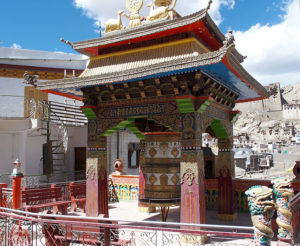
Wandering through the streets, markets, and footpaths of Leh was a real pleasure, and one of the many reasons that we were content to stay there for so long. Cows, donkeys, goats, dogs, and Royal Enfield motorcycles roam the narrow passages. Traditional homes constructed of handmade clay bricks, stone, mud, rough logs, and intricate woodworking are set in oddly shaped plots of land filled with vegetables and grazing land and connected by networks of irrigation channels which flow constantly but are only diverted for use when necessary. Coarse stone walls surround many of the plots mostly to keep the more independent cows from eating their vegetables. Some people have their own cows for which fields of grass and barley are cut, dried, and stored on the roofs for feeding through the winter. Cows are not killed and eaten but rather maintained as an important link in the natural cycle, providing milk and fertilizing the soil. Their abundant patties are also collected and dried for use as fuel. Certain parts of town have a rural feel but other parts are a dense maze of crumbling ancient buildings smooshed together in patterns that only make sense in a world before automobiles. Squeezed into the most unlikely spaces are a wide variety of religious structures – temples, mosques, monasteries, stupas, chortens, prayer wheels, piles of prayer stones, and probably other things that I wouldn’t be able to identify. It’s a fascinating town with a lot to look at.
The buildings of Leh are definitely something special. Most of the newer developments use concrete and steel reinforcement but the more traditional buildings are made with massive stone and mud walls and only a very small amount of wood, since there aren’t that many trees around. In the older part of town many of the buildings aren’t rectangular and are built to fit the space and landscape in bizarre ways. The simple materials reflect the colors of the dry rocky landscape and appear to grow from the hillsides like salt crystals, with an inherent geometry that is applied in a completely loose and organic way. An interesting culmination of this crystallization is the abandoned royal palace which overlooks the town from a high point and looks like a cross between a medieval fortress and a Tibetan monastery. One afternoon we walked up to the palace and meandered through the decaying labyrinth of stone hallways and chambers.
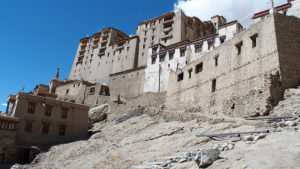
Ladakh has two main roads that connect it to other parts of India and because of the rugged terrain and high altitude it gets largely cut off from the rest of the world during the snowy months, which are about half of the year. A harsh and unforgiving environment has bred a certain self-sufficiency into the Ladakhis. Where we were staying they had a nice piece of land with something straddling the line between large garden and small farm. Our upstairs window looked out over a field of potatoes, cabbage, onions, carrots, large radishes, cauliflower, peppers, zucchini, surprisingly good tomatoes, and herbs. As far as I could tell they grew almost all of their food and also sold produce to friends and people who resold it at the street markets. Most mornings, nice and early, we would see them working in the garden. At this point in the season, which was September, crops were being harvested in preparation for winter. The first snow would most likely come in October and we could see snow collecting on the nearby mountaintops. Nearly half the land was devoted to potatoes which were slowly being dug up and stored in a cellar. On a couple of mornings, Tsering, who happened to be a professional ice hockey player, was out there cutting the seemingly overgrown grass by hand to save and use for feeding his parents’ cows. We always knew when he was out in the garden because we’d hear him firing off a few rounds with his bow and arrow. Thump. Thump. Thump. An energetic and athletic man, he always nailed the target.
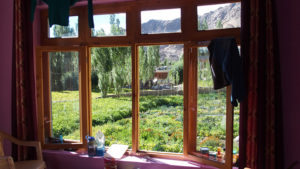
Clean mountain water came to their home by a stream and it was heated with an amazingly effective solar water heater, which could also be seen on the roofs of many of the newer guesthouses around town. They had electricity but there were almost daily power outages for many hours at a time. They had internet access but the internet only functioned city-wide for a fraction of the time. Even regular telephone service was frequently unavailable. How could a town this size (30,000+) survive without basic telecommunications? Obviously people have been taking care of themselves without electronic communication for thousands of years and the Ladakhis seem very comfortable relying on older modes of survival.
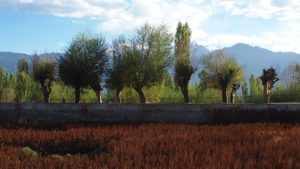
Some of the disruptions, according to the locals, were due to the escalating violent conflict in Kashmir, which is Ladakh’s western neighbor. There was indeed a substantial military presence, but things were peaceful in Leh. Many people, especially Indians, have told me that Kashmir is one of the most beautiful places they’ve ever seen and I would have liked to go there but fortunately I looked into the security situation before we made our plans. It had been relatively calm for years but just before we were heading to northern India, in July or August, sparks ignited a decades-long smoldering conflict involving Pakistan, Kashmiri separatists, and the Indian government. Apparently there were strict curfews, business was halted, telecommunications were regularly cut off, and there were military check points everywhere. We could have gone there but it wouldn’t have been much fun.
Seeing how traditional Ladakhis get by and maintain a relatively sustainable and isolated existence was truly inspiring. Unfortunately the influx of people from neighboring areas as well as the recent dramatic increase in tourism will probably have a negative impact in the long run, particularly since resources are scarce. For many years I’ve had an interest in self-sustaining living situations, especially when it comes to natural and sustainable building techniques as well as farming and raising food. In the US there are so many factors pressuring against such a thing, forcing people into unhealthy lives that don’t bring them happiness. In Ladakh it is perfectly normal since they can’t rely entirely on modern infrastructure or support from the outside world. It’s nice to see that they aren’t just scraping by. Our hosts were certainly better off than many in the area and I know that there are plenty of very poor people in Leh but it was really nice to see them living close to the earth and having such a high quality of life. The two boys of the family were healthy and bright. The older son (15?) had an easy smile and was extremely well mannered. The younger son (11?) took after his father and would sneak off to buy chicken to eat since his mother was vegetarian and didn’t cook meat for the family.
Like many Ladakhis, the people we stayed with were reserved, respectful, and observed their religious traditions. They kept to themselves and had tight social and family networks, which is understandable since it is likely the increasing influence from outsiders that will ultimately destroy their traditional way of life. They also showed an unusually high degree of integrity and honesty in their business dealings, which was a refreshing change from what we’d gotten used to over the previous month or so. Money is not necessarily the most important thing to them, which is a perspective that I can respect and relate to. Fern and I were lucky to have this experience and we wondered what it would be like to spend a winter in Leh. That would be something else entirely.
Overall we spent almost three weeks in Leh, adopting a nice slow pace. The coolness of the high mountain air, the intensity of the sun, and the extreme dryness made it comforting and slightly unsettling at the same time. It took a long time to adjust to the altitude, over 11,000 feet, and I can’t say for sure that we ever completely got used to it. Walking up a single flight of stairs or simply standing up would make my heart pound and my breath quicken. We walked a lot, partially for the sheer pleasure of it but partially because there were no restaurants in our immediate area. We would walk to the town center just about every day for food. The Ladakhi staples of thukpa and momos got a little old so we usually ate at one of the Punjabi dhabas which were reliably delicious and ridiculously inexpensive. Our hosts told us we could pick and eat any vegetables we wanted from their garden which opened up some possibilities. We got creative with food preparation in our room, exploring lots of ways to use raw vegetables and other locally available ingredients like fresh paneer, ghee, chick pea flour, flatbreads, kashmiri curry paste, etc. Even managed to whip up some Mexican pico do gallo and made “tacos” with paneer and cabbage leaves instead of tortillas. Turned out pretty good.

There was something meditative and comforting about sitting in front of our window chopping vegetables while looking out at the garden from which they came, not to mention the warm evening light and mountain scenery off in the distance.
That is something I could get used to.
Many aspects of small town Ladakhi life made Fern and I think about what kind of life we want when we return to the United States, but that’s a whole different train of thought…
jim@snorkelbandits.com

